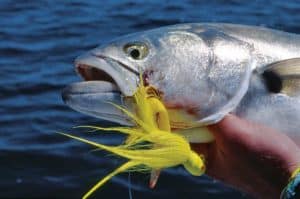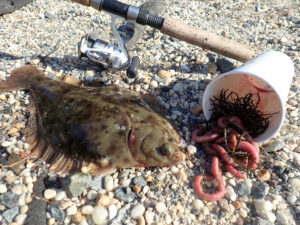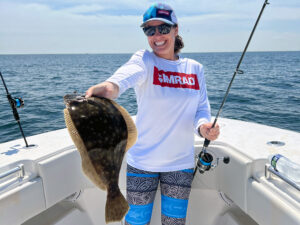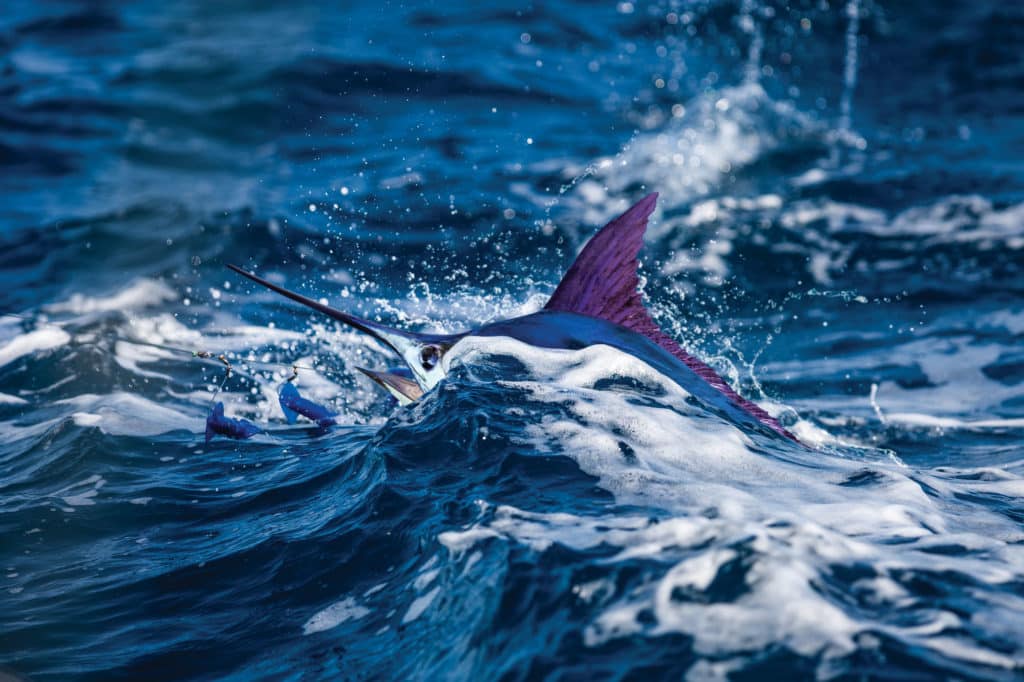
We were feeling pretty lucky: Fishing 50 miles off Virginia Beach on the hottest day of summer, my friends and I had already fooled two white marlin that came in on the left teaser. One fish peeled off to the right flat line and the other circled back on the left long.
Mid-Atlantic anglers dream all winter about hooking and releasing white marlin, and practice all summer, so the guys managed the chaos like clockwork. The anglers dropped back baits as the captain put the boat in a circle. Then, a silent 10-count.
The guys on the rods engaged their drags and cranked tight. Five feet of blade-wielding muscle exploded out of the water on both sides of the boat.
The engines revved to an angry growl, and we gave chase as the anglers cranked like hell. In a couple of minutes, we had two fish tap dancing off the port side. Black smoke erupted from the exhaust as the skipper spun the boat and backed toward the fish. With waves of electric-blue Kool Aid crashing over the stern, the mate reached out, grabbed the leader, gave it a tug, and the first fish was freed.
We repeated the process with the second fish: crank, black smoke, blue water sloshing in the cockpit, and a quick marlin release celebrated with hoots and high fives. Still buzzing on our success, we went to work resetting the lines and preparing for the next bite.
A few hours later, a blue marlin slashed at the squid chain like Freddie Krueger. Someone grabbed a heavy rod and reel and deployed a whole Spanish mackerel. In seconds, the giant exploded out of the water and disappeared with the bait. Two hours later, we saw the fish again as the angler slowly worked it to the surface. The mate reached out, grabbed the lure, and slashed at the leader with his release knife.
The crew broke out in cheers. I slapped the angler on the shoulder and could feel his muscles still tight. Celebration was short-lived: We jumped back into the action, resetting the lines and rigging a fresh mackerel on the pitch rod.
As calm returned to the cockpit, the drone of the engine lulled us into a silent realization. I was the first to utter the unspeakable dream: “Hey, we’re two-thirds of the way to a slam.” My buddies chuckled nervously, and the captain replied, “That would be a freaking miracle.”
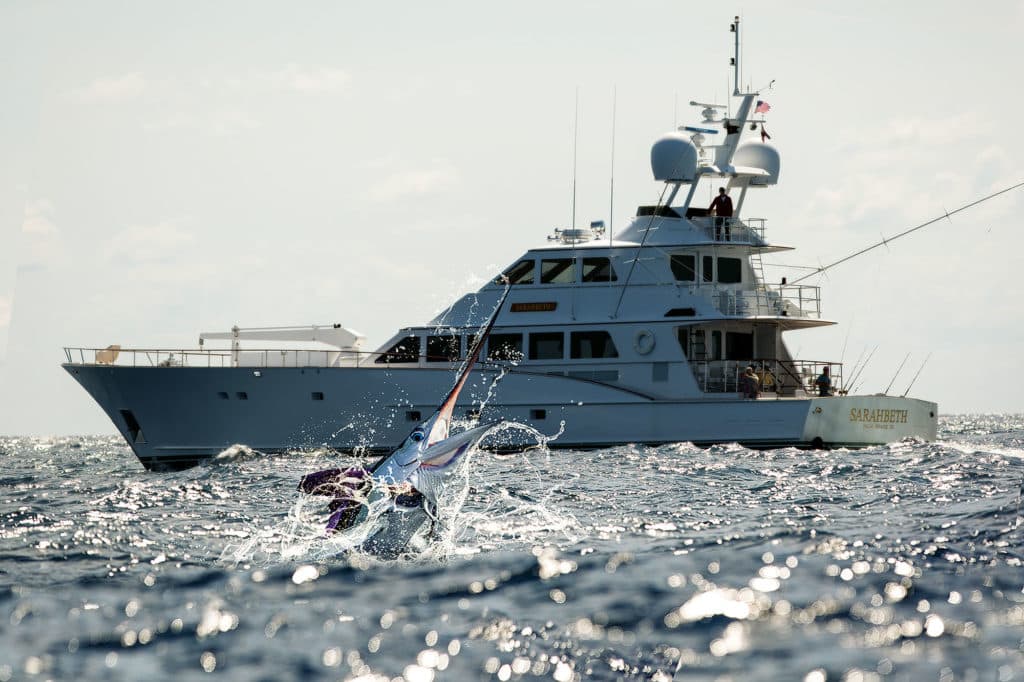
Mid-Atlantic Miracle
Catching three species of billfish in one day ranks as one of the greatest accomplishments for any angler. Crews fishing from North Carolina to New Jersey can target five billfish species, including swordfish and spearfish, but the best chance at a slam comes from targeting a blue marlin, a white marlin and a sailfish.
While scoring a slam is possible almost anywhere these fish are caught, heading out to target such a feat would be almost folly. Capt. John Bayliss, of Bayliss Boatworks out of Wanchese, North Carolina, has several slams under his belt, but he’s the first to point out that each one was influenced by chance. “It’s the luck of the draw,” he admits.
One of his favorite hat tricks combined good friends with new anglers on a fun trip on a late-summer day. “We caught eight white marlin and a blue,” he remembers. With a great outing already in the books, and a slam on the line, the crew decided to focus on catching a sail. “We trolled until dark before we hooked the sailfish,” he remembers, glowing about the excitement of sharing the experience with anglers who had never caught a billfish.
Bayliss’ home waters, along the famed Outer Banks, offer the best chance at hitting a slam in the mid-Atlantic region. Anglers can encounter blues, whites and sails in any of the warmer months; the largest body of fish pass by in May and June, and then again in August and September.
In late spring, warm Gulf Stream water rushes up the East Coast, hitting the Outer Banks and swirling to the east. Starting in May, marlin ride the highway north, typically congregating in cooler eddies with less current.
Bayliss monitors satellite water-temperature images looking for anomalies where the current whips a lasso of cooler water. The outer edges of the loop are warmer than the center, where the current sometimes flows downstream. “The water temperature can be 3 degrees cooler, and the current will often turn southwest,” he explains.
Early in summer, boats leaving Oregon Inlet head south and fish off Hatteras Inlet, where the marlin — especially blues — stage before catching a ride north on the stream.
Late in summer, billfish return en masse riding the same spiraling eddies south. From late August through early October, Bayliss heads east or northeast to find the fish along the continental shelf.
Again, the first step is finding marlin water. Bayliss describes perfect conditions as blended water — clear blue with perhaps a little green mixed in — and no current or a little down-current. He looks for water temperatures between 78 degrees and the low 80s. The fish can stage offshore in water deeper than 1,000 fathoms (1 fathom equals 6 feet) or inshore as shallow as 40 fathoms.
In late summer, those conditions can occur anywhere between Atlantic City, New Jersey, and Hatteras Island, North Carolina. The fish move based on where the cooler eddies break off the Gulf Stream and how they spin south. Bayliss points out, “Some years, they are straight out of the inlet, and some years, the fish stay north off Virginia Beach or Ocean City, Maryland.”
Scoring a slam requires perfect conditions, but when water temperature and current match up, anglers get a shot at blues, whites and sails.
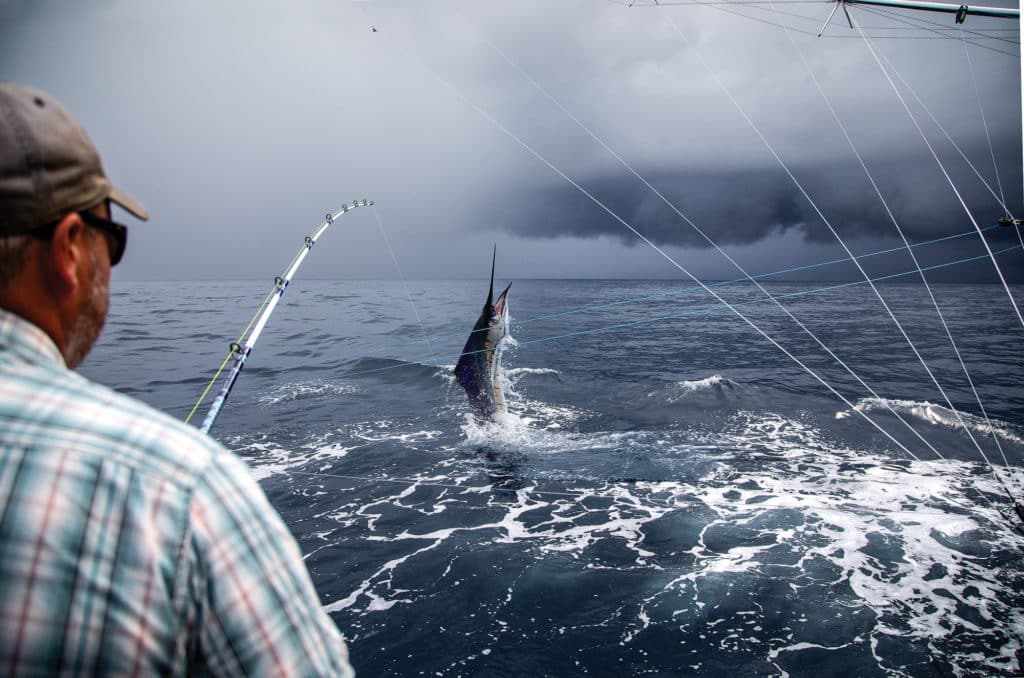
Spread Thin
Virginia Beach is marlin central, a jumping-off point for Washington and Norfolk canyons and the fertile waters offshore of Oregon Inlet. Fishing out of Rudee Inlet, Capt. Jimmy Bayne keeps his 58-foot sport-fisher, Sniper, in the middle of the action. After years of experience, Bayne has honed his trolling spread to its simplest form. He says with a laugh, “I’m almost embarrassed to admit, I’ve been doing the same thing for years.”
Like most captains, Bayne leaves port with white marlin on the mind. The mid-Atlantic in late summer offers some of the best white marlin fishing in the world. “Blue marlin and sailfish are mixed in,” Bayne adds, but the focus is on “Mr. White.” Since the development of dredge-fishing, crews on both ends of the white’s range are pulling variations of the same spread.
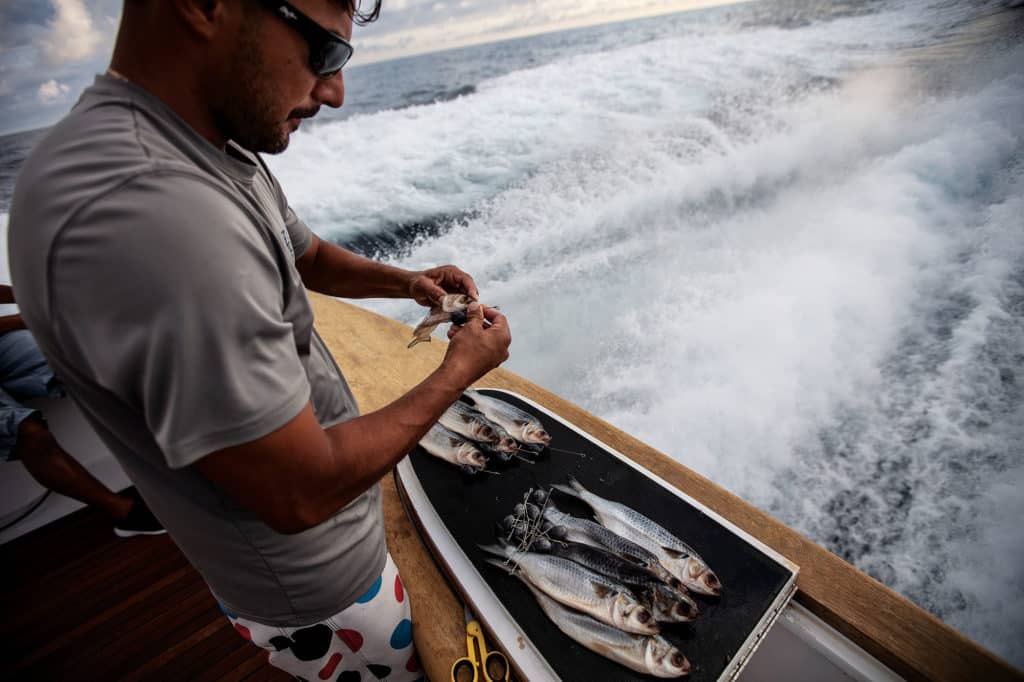
The layout starts with a pair of dredges. “You can go two or three tiers,” he says. Mullet or ballyhoo, with half the baits behind Iland skirts, comprises the most popular combination. But Bayne has started to experiment. “We’ve had good results using Sassy Shads and Ilands on the inside of the dredge” he says. The artificial shad “thicken up the dredge,” providing a heavier profile to attract blue marlin with a big appetite.
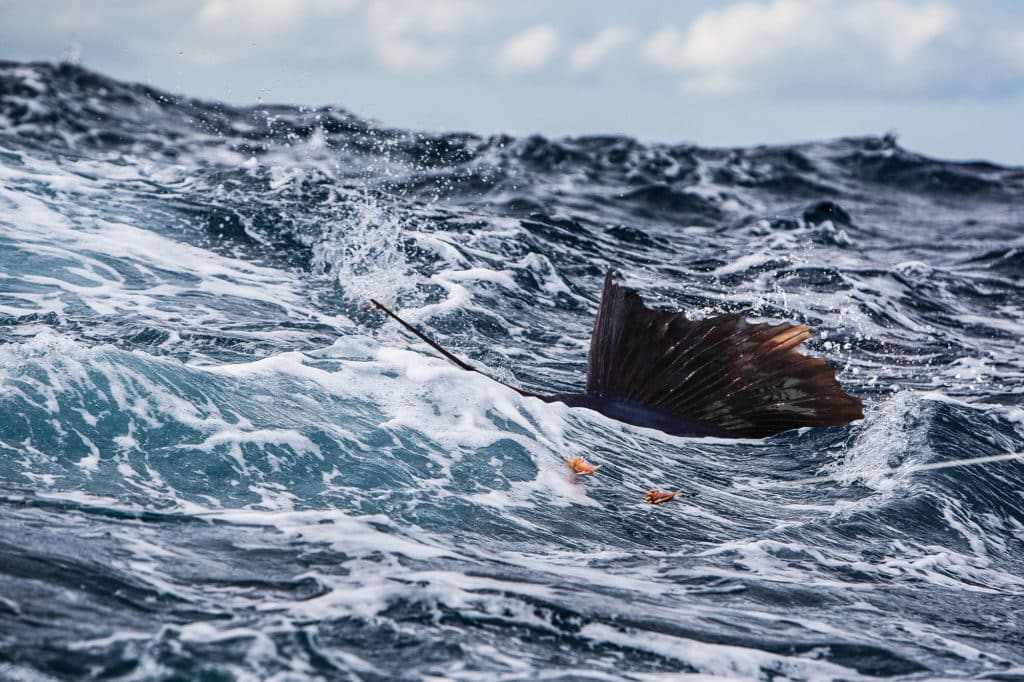
The dredge swims just below the surface behind a 6- to 8-pound trolling sinker. On the surface, outside the dredge, he pulls a chain of six or eight rubber squid punctuated with a large ballyhoo behind an Iland skirt. The most popular combo is a green chain on one side and pink on the other, but Bayne experiments with colors and squid sizes if he’s marking fish and bait but getting no love.
To keep things simple for the fish and the fishermen, Bayne and crew limit the spread to four small, naked ballyhoo and one Iland Xpress and large ballyhoo. He also keeps two dink baits and a rigged Spanish mackerel ready to deploy.
He fishes the dink baits on the flat lines, one long rigger and one short rigger. The ballyhoo and Xpress go on the other short rigger, or on a long rigger. He keeps the lures close to the dredge and teaser, making them easier to watch. The combination of small and large baits gives him something to offer blue marlin, whites or sails. “You just have to drive in front of the right fish,” he says.
That’s how Bayne scored one of his most memorable slams. He laughs again, saying, “It was total luck.”
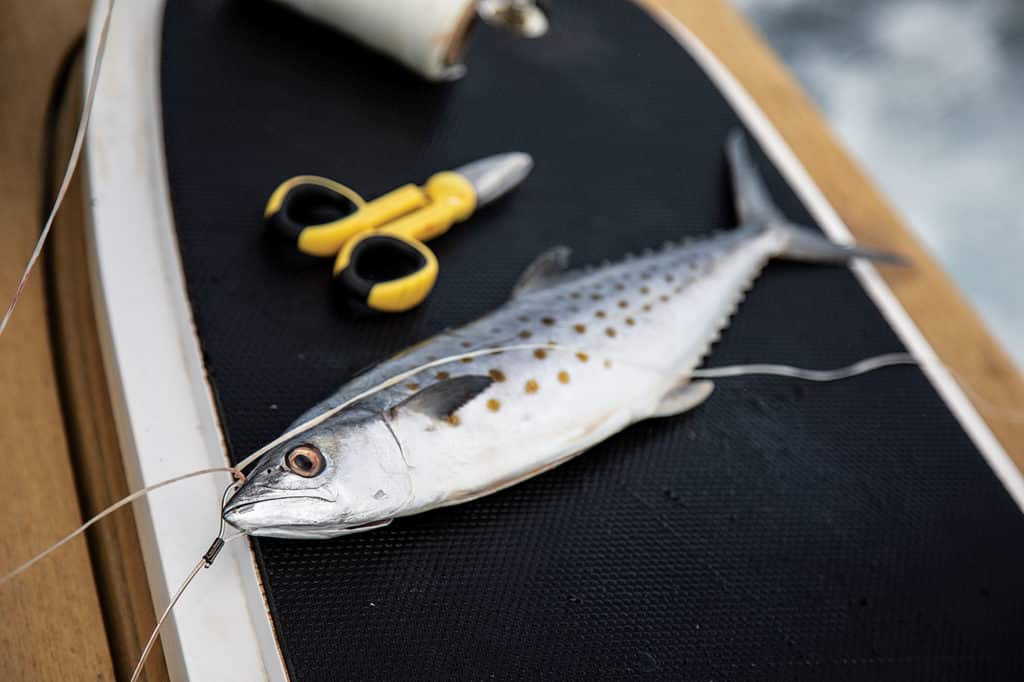
He remembers his crew catching several whites and a blue marlin. “We decided to try for the slam.” Bayne trolled inshore and turned his attention to finding a sailfish. “We fished late and didn’t see a sailfish,” he remembers. A little disappointed, Bayne called the day, and the crew brought in the lines and raised the riggers.
“We were running in when I spotted something on the surface,” he says. He slowed the boat to investigate. “A pack of sailfish was cutting a school of bait.”
No time to waste, the anglers dropped four dink baits off the rod tips. Bayne put Sniper in a circle around the action, and the rest was history.
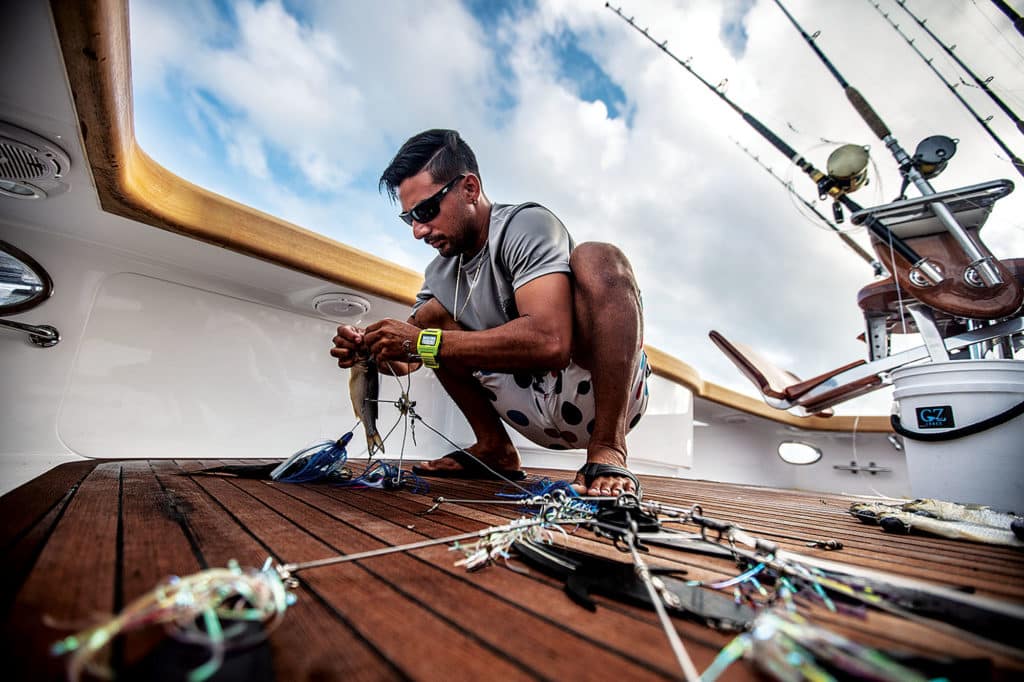
Make Your Luck
Luck be damned — when the opportunity arises, it also takes skill to close the deal. Some people say Capt. Jon Duffie is one of the luckiest skippers out of Ocean City: He set the local record with 57 white marlin releases in one day. Fishing with his family, his Billfisher team is a regular on the tournament scene. Duffie’s good, but he’s not too proud to admit that catching a slam is a crapshoot. “It’s like getting struck by lightning.”
Duffie says he’s caught slams in 700 fathoms at the mouth of the Washington Canyon and 50 fathoms at the base of the Norfolk. Despite the distance, skill and strategy increase the chance at a blue, white and sail.
“The sailfish is the wild card,” Duffie says. Chances are better for bites from blues and whites. “When I catch a sailfish, I really start to feel the pressure.”
With a sailfish and white marlin in the books, Duffie changes up the spread in hopes of scoring a blue marlin. If he’s marking bait in the area, he’ll add an Iland Xpress and large ballyhoo to each short rigger and beat the water. If he’s not seeing signs, Duffie goes on the hunt. “We’ll switch the natural dredges for Mudflaps,” he explains. And he’ll change one or both squid chains for a big swimming lure.
Read Next: Billfish Teaser Tactics of Tournament Experts
Duffie might keep the dink baits in the mix, but he’ll change the short riggers to slant-faced swimming lures. Trailing big lures and an artificial teaser, he can bump up his speed to about 8 knots to increase chances of crossing paths with a blue marlin.
For the best shot at a blue, he usually heads deep, trolling through the mouth of the canyon toward the corners and over deep humps. But a blue isn’t guaranteed. “I’ve gone many days with the sail and white and never found the blue,” he admits.
If the scenario finds Duffie with a white marlin and blue and looking for a sail, he keeps the dink baits, chains and dredge, and beats the area looking for bait and cutting dorsal fins. Other times, he’s had the opposite luck. “I once had four sails and couldn’t catch a blue or white,” he says.
Duffie and the other captains admit that conditions really have to come together for the best slam chance. “A day with a lot of fish is a good start,” Duffie says. He looks for a hard temperature break, light winds, flying fish, scattered sargassum and pretty blue-green water. “The times I’ve caught slams, all the conditions were perfect.”
The mid-Atlantic angler’s moral? To score a mid-Atlantic billfish slam, take advantage of opportunities, and sprinkle in a little luck and perfect conditions.
About the Author
Ric Burnley is an angler, editor, author and teacher who lives in Virginia Beach, Virginia. When he isn’t fishing or writing, he’s in the classroom teaching at-risk teenagers that the pen is mightier than the sword.
Slam Stats
Scoring a white marlin, blue marlin and sailfish off the mid-Atlantic coast takes a bit of luck and a lot of skill. Learning how to pattern these fish as they migrate through is key to finding them when the time and conditions are right.
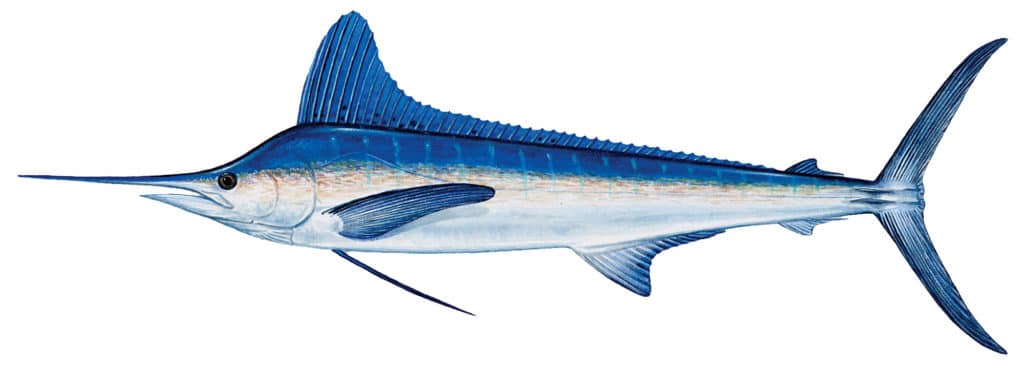
One of the world’s great sport fish, white marlin offer it all: fast action, exciting bite, violent fight, ending in a clean release. Mid-Atlantic whites average 50 pounds, with bruisers pushing 80.
The fish arrive off Hatteras in June, then skip up the coast through summer. The best action is late in the season as the fish amass and move south. The key to finding white marlin is interpreting satellite water-temperature images for eddies of cooler water swirling off the Gulf Stream.
To indicate the number of marlin released, anglers hang flags from their outrigger halyards. To increase the number of flags, smart crews cut the spread to four small rigged ballyhoo, keeping confusion to a minimum
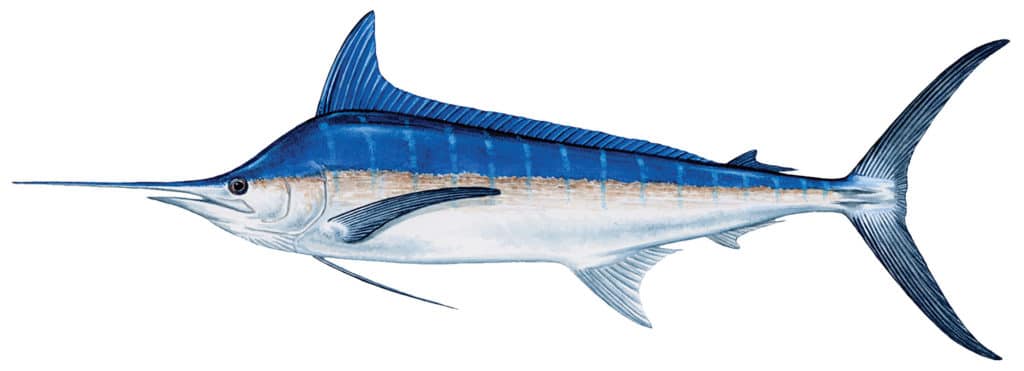
Weighing up to 1,000 pounds, Atlantic blue marlin are among the largest sport fish on Earth. Big and bold, blues do their own thing: They go where they want, and are just as likely to travel the eddies and temperature breaks as to range into the deep blue or push shallow.
Blue marlin prove most predictable when they arrive at the rock piles and cliffs off Hatteras in April. The season starts with a series of blue marlin tournaments, wherein crews troll artificial plugs to cover the most water in search of an encounter.
It takes a ton of food to fuel a sea monster. Blues follow their stomachs to feed on dolphin and tuna moving up the coast through summer. Blues join their white and sail-finned cousins, cruising down-current on late-summer eddies.
To entice blue marlin to the spread, add a large ballyhoo behind a large skirt. Locals call a pink Iland Express “Ol’ Pinkie.”
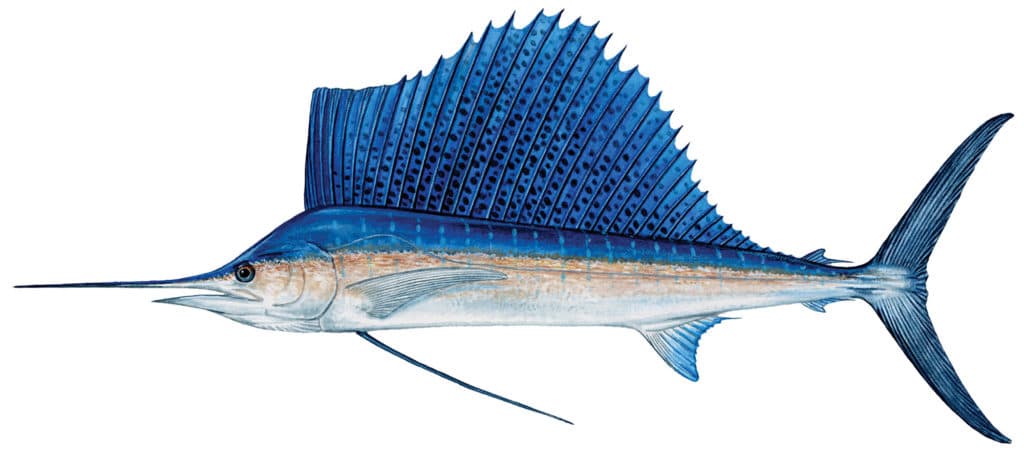
Sailfish represent the anomaly in a mid-Atlantic billfish slam. Blues and whites act more predictably, but sails can be anywhere. The best place to intercept a sail is inshore off Hatteras. Look for sailfish around wrecks and rock piles in spring and early summer before they join their billed brothers on the ride north.
In fall, the fish roll south on the edge of the Gulf Stream, following schools of bait. The rule of thumb: Fish as shallow as 20 fathoms. Sails often hunt with white marlin.
The smallest slam member, sailfish weigh less than 50 pounds but put on an incredible aerial display with their expansive dorsal fin. Once you release a white and a blue offshore, head inshore to troll dink ballyhoo around humps and drops.

